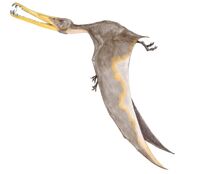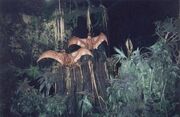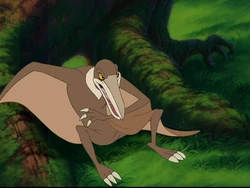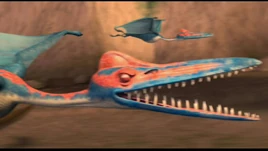
Cearadactylus atrox.
| Cearadactylus | |
|---|---|
[[file: Cearadactylus | |
| Scientific classification | |
| Kingdom: | Animalia |
| Phylum: | Chordata |
| Class: | Sauropsida |
| Order: | Pterosauria |
| Suborder: | Pterodactyloidea |
| Family: | Ctenochasmatidae |
| Genus: | Cearadactylus Leonardi & Borgomanero, 1985 |
| Species | |
| |
Cearadactylus atrox (meaning "Ceara's lethal finger") was a large, mid-Cretaceous (Aptian) pterosaur. Its wingspan is estimated to have been around 4 to 5.5 metres (13 to 18 feet), with a weight of perhaps 15 kilograms.
Its kinked upper jaw and its interlocking teeth suggest a piscivourous diet, allowing the animal to keep hold of slippery fish.
The type species is Cearadactylus atrox, described and named by Leonardi and Borgomanero in 1985. It was discovered on the Araripe plateau (Santana Formation) in northeastern Brazil and is known from a single skull.[1]
In popular culture
- It was in the original Jurassic Park novel by Michael Crichton.

Sierra the Cearadactylus
- In The Land Before Time VII: the Stone of Cold Fire there is a sinister Cearadactylus named Sierra. He and Rinkus, a Rhamphorhynchus, are the main antagonists of the film.
- In Ice Age: Dawn of the Dinosaurs they appear in the third film chasing Buck, Crash and Eddie while they were flying to save Sid in Lava Falls. They almost caught them but Buck piloted Roger to Lava Falls. He pulled up sharply in front of a lava waterfall, but the Cearadactylus were unable to pull up fast enough and they plunged straight into the lava.

References
- ↑ Leonardi, G. & Borgomanero, G. (1985). "Cearadactylus atrox nov. gen., nov. sp.: novo Pterosauria (Pterodactyloidea) da Chapada do Araripe, Ceara, Brasil." Resumos dos communicaçoes VIII Congresso bras. de Paleontologia e Stratigrafia, 27: 75–80.
- Unwin, D.M. (2002). "On the systematic relationships of Cearadactylus atrox, an enigmatic Early Cretaceous pterosaur from the Santana Formation of Brazil." Mitteilungen Museum für Naturkunde Berlin, Geowissenschaftlichen Reihe, 5: 239-263.
